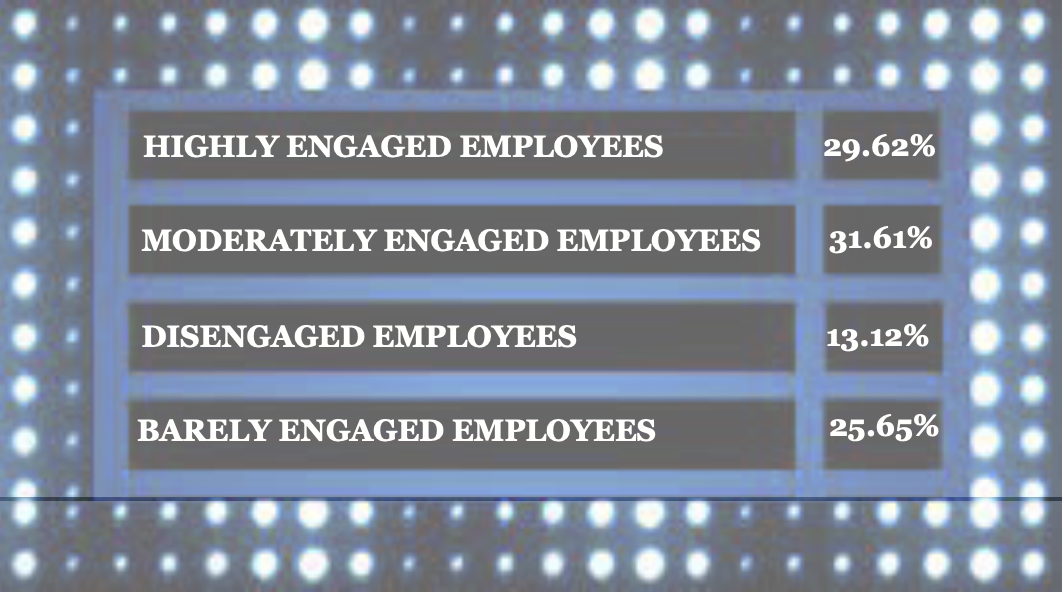College employees speak out against salary disparity, college culture in anonymous survey
BY: JACOB POLITTE
Managing Editor
Despite the college’s best hopes, STLCC did not pass the test to qualify as a Best Place to Work through the St. Louis Business Journal.
The college submitted itself as a contender in St. Louis Business Journal’s Best Places to Work program. This program, used across the nation in various big cities, determines what organization in the given metropolitan area is the best workplace through a variety of factors, including employee feedback. While Chancellor Jeff Pittman and Board Of Trustees Chair Kevin Martin expressed optimism regarding the college’s future and expressed their intentions to continuously work to improve STLCC, the employee responses told a much different story.
The numbers behind the survey
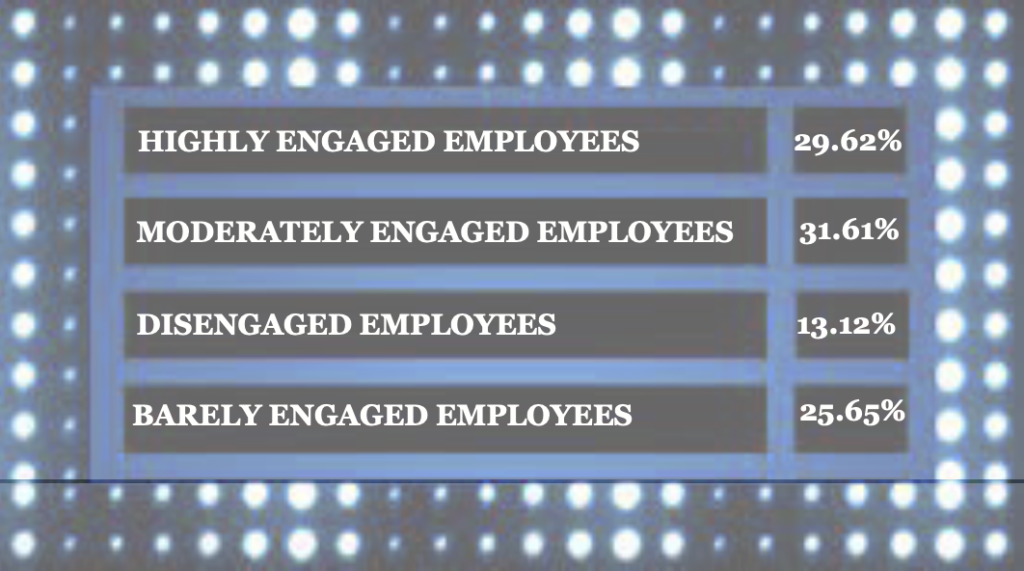
The survey found that of the 503 employees that participated in the survey, 149 (29.62%) were considered to be “highly engaged” while 159 (31.61%) were considered to be “moderately engaged.” Meanwhile, 66 (13.12%) employees were considered to be “disengaged” while a staggering 129 (25.65%) were considered to be barely engaged.
Meanwhile, the survey found that the college’s benefits score is higher than many colleges of the same size in the region, and four points greater than the average of the finalists.
Pittman touted that result in his email to faculty and staff.
“Our benefits rated high,” he said. “In fact, STLCC’s benefits score ranked higher than the average finalist of similar-sized organizations.”
Regarding the employee participation in the survey, he said, “We had 503 employees complete the survey – an impressive number that shows people want their voices heard.”
Some employees definitely made their voices heard, and none of the comments contained in the copy of the report provided to The Montage were positive.
An overview of faculty and staff responses
One unnamed Meramec employee was not happy with the college, saying “There are many other aspects to the student experience I’d like to divulge but there won’t be enough space in this survey to digress. The lab spaces are antiquated and crowded and equipment needs to be updated as do the science buildings. The lighting is dim and dreary down the hallways, the buildings are covered in mold and the roof leaks. No one on the Meramec campus can understand why we are not getting an Allied Health building, and why so much money is being put into the Florissant Valley campus.”
Later on, this person continued, “The Meramec campus is strategically located to serve a greater population and is in proximity to the greatest number of hospitals (greater opportunities for clinical opportunities) and contains a vast population of students whose needs and desires are NOT being met in the area in which they live, and they will NOT drive to North County to satisfy their needs, they will go to another college, plain and simple.”

Regarding this matter, Pittman said, “The College has strategically planned for an expansion of all its health care programs across the Region and will construct new health care structures and expanded programming at the Flo Valley and Wildwood campuses as a part of STLCC Transformed. In addition, there are plans to expand our health care programs at South County with the addition of a new Licensed Practical Nursing program. These expansions were carefully planned by assessing area hospital clinical capacities and in aligning with current workforce needs.
He continued, “While Meramec continues to be an important part of the district’s overall expansion plans, the College is dramatically expanding several workforce programs to meet area workforce needs as determined by the employers we serve. Our Meramec campus focus under STLCC Transformed will include the construction of a financial services center and an emerging technologies center. These projects are currently estimated to cost more than $138 million.”
Another anonymous employee did not mince words when criticizing the college and the chancellor, and believes that the college is out of touch with what students, faculty and staff require.
“First, the fact that the institution nominated itself for this award shows just how disconnected leadership is from its employees,” they said. “Anyone with a true understanding of the internal complexities of the institution should not invite this type of attention. The Chancellor’s success is based not on his ability to connect and his commitment to making St. Louis Community College the best it can be, it is based on his political affiliations and comfort rubbing elbows with the Governor.”
This person also goes on to heavily criticize the college’s leadership team.
“It is quite possible that STLCC would be no more if the State showed up and conducted internal audits. Leadership certainly does not give much weight to quality of life. Instead of accommodating the needs of employees, those who are not facing the same issues as the majority of employees make decisions about what those employees need. Leadership does not have the tools to effectively manage, and the management experience of leadership is questionable. The Leadership Team is devoid of real representation and is instead a personification of tokenism, ripe with individuals meant to placate instead of challenge.”
Later on in this person’s remarks, they accused the Chancellor of inappropriate comments and behavior regarding departing employees.
“The Chancellor also has a known habit of making horrendous comments about those who move on to better opportunities and [a known habit of] treating them terribly upon receiving resignations.”
This person also accuses the college’s leadership team of similar behavior.
“The archaic nature of the leadership has resulted in low morale and an ineffective workplace. There is a lack of professionalism and the lack of accountability embedded in the culture of the institution is palpable,” they said. “Leadership’s disregard is evident in the way they speak to others, disregard valuable input, and treat others. For example, it’s not uncommon for management to punish employees for the very type of behavior displayed by management/leadership. Instead of setting expectations, many leadership members gossip about their own employees and complain about insufficient output. There is an “it’s not our job” mentality here, and there is often hostility where there should be collaboration.”
Later on, they continued, “There is no one on the Chancellor’s leadership team who has indicated an ability to willingness to have tough conversations. As a result, the workforce is suffering, but leadership makes every excuse to blame the workforce and avoid all accountability.”
Later on, they also accuse the college of targeting employees who speak out against it, saying “It’s worth noting that certain employees are unlikely to complete this survey due to fear of retaliation. There have been instances during which internal “anonymous” surveys have been completed, less than flattering feedback was provided, leadership was able to identify the authors, and those authors were retaliated against. The microaggressions are real here. The disregard for those from different walks of life is real here.”
Criticism of the college administration continued in another review, with another anonymous person saying, “The administrators are so far removed from the day to day activities of the college that they have lost sight of what it takes to properly run the institution. They are so focused on outcomes that they have forgotten about the people pushing to achieve those outcomes.”

Further commenting on employee turnover, this person continued, “The environment has become so hostile that staff turnover has skyrocketed. New people come in and stay less than a year and move on. They realize STLCC is not a great place to work. STLCC has truly gone downhill over the years. Employees are undervalued and treated poorly and unfairly. They are denied the opportunity to advance because the current leadership prefers to hire their friends over internal candidates with years of experience. We were once a place that fostered the growth and advancement of our own, but no more. There is blatant favoritism for those who do not speak out against leadership. If someone wants to advance, they must always agree with leadership and never question them. The college no longer values people who work hard and do their job. Instead, they value employees who show up every day and do the minimum. People who do their job are now expected to pick up the slack for those who do not. Being an employee who takes initiative is discouraged. Professional development opportunities of substance are only afforded to those favored by leadership. For those who have been with the college for years, we have seen this decline firsthand.”
They further continued, “This entire company is a hostile work environment with leadership that is so full of their own bravado that they think they are never wrong and are above reproach. They push their own personal agenda without regard for the best interests of students or staff.”
This person, like others, stressed that this isn’t the first time that the college has conducted a survey like this.
“Every time they conduct one, they ignore the results because they are critical of leadership.”
Regarding these accusations, Pittman expressed disbelief and denied the allegations.
“I disagree with this anonymous comment,” he said. “And it is impossible to understand what this is about given there are no names or details provided. I do not make ‘horrendous’ comments about current or past staff, and, in fact, I often serve as a coach and supply references for those who wish to further their career at other colleges.”
Pittman then cited two examples of assisting two former high-level administrators of STLCC acquire CEO positions at other Colleges and assisting another high-level leader obtain a similar job at a larger college. He also says that prior to COVID, he had offered the Chancellor’s Leadership Academy to provide leadership training to aspiring community college faculty and staff, and post-COVID, “we are working on plans to begin this program once again in the not-too-distant future.”
Pittman also addressed the criticism of college leadership by saying, “It is difficult to respond when there are no employees named or specific incidents identified. I have not witnessed unprofessional behavior or gossip personally and believe our leadership team is working very hard to create an environment where people feel valued.”
Lastly, regarding the allegations of the college seeking to identify those who may respond in an anonymous survey, Pittman said, “I am not aware of any incident since I’ve arrived in 2015 where any employee has been identified or retaliated against because of completing an anonymous survey. There is no way for us to connect comments in these surveys back to the participants.”
He continued, “I find the faculty and staff here very forthcoming in stating their opinions about any topic they feel compelled to comment about, as illustrated at our board meetings for the past several years. And yes, the fact we are committed to the work associated with the ‘Best Place to Work’ initiative illustrates that I and the other leadership members value the input and contributions of non-administrative employees.”
Salary Disparity and the college budget come to the forefront
That unnamed Meramec employee finished their comments by talking about salaries.
“And if the college doesn’t get a clue and start paying their classified employees a better salary (I have an Associates Degree and the housekeepers make almost as much as I do…..ridiculous, and I’m the lowest paid for the same title for some reason with others being hired at higher rates while I hold the most experience) they will lose a great population of hardworking people who have been dedicated to the college for a long time. We are the ones at the “bottom” making all of the magic happen for the students, supporting the professors, etc. The administrators make far too much money, and receive ridiculous bonuses and this doesn’t bode well from our viewpoint. The maintenance mechanics are the only employees paid a fair wage……why? Look at where people are leaving and why, please pay attention……”
Another employee said that their raises have stopped because they were told that “they make too much money.”
They said, “This was very insulting to me knowing that I have gone above and beyond my job responsibilities, have always gotten great evaluations, and positive feedback from students, staff and external stakeholders but I make too much. Several salary studies have been done in my time at the college yet none have amounted to anything. Several organizational studies have been done and again not followed. To me these studies would be more important than ever given everyone here is new(and making more money than predecessors who were highly experienced). Experience should count for something.”
Administrative salaries

During their November 2022 meeting, the Board of Trustees unanimously approved extending Chancellor Pittman’s contract through June 30, 2027.
Kevin Martin says that the Board takes its role in hiring and evaluating the chancellor, who he deemed the Board’s “sole employee” very seriously.
“Dr. Pittman goes through an extensive evaluation process each year, which is outlined in Board Policy,” Martin says. “Generally during a mid-year check, the Board has a discussion about any contract extensions and we initiate the conversation with the Chancellor. The Board has been very pleased with the performance and direction the College is heading. We have a strong strategic plan in place, we have been able to pass a bond issue to transform the College and region, we continue to improve our benchmark indicators, our presence has been elevated among the region and state, among many other things. It is common in higher education to have at least a three year rolling contract. As a Board, we have found Dr. Pittman’s leadership and stability it has brought to the College to be invaluable, which is why we have had two five year spans of a contract. We are very pleased with Dr. Pittman and his performance.”
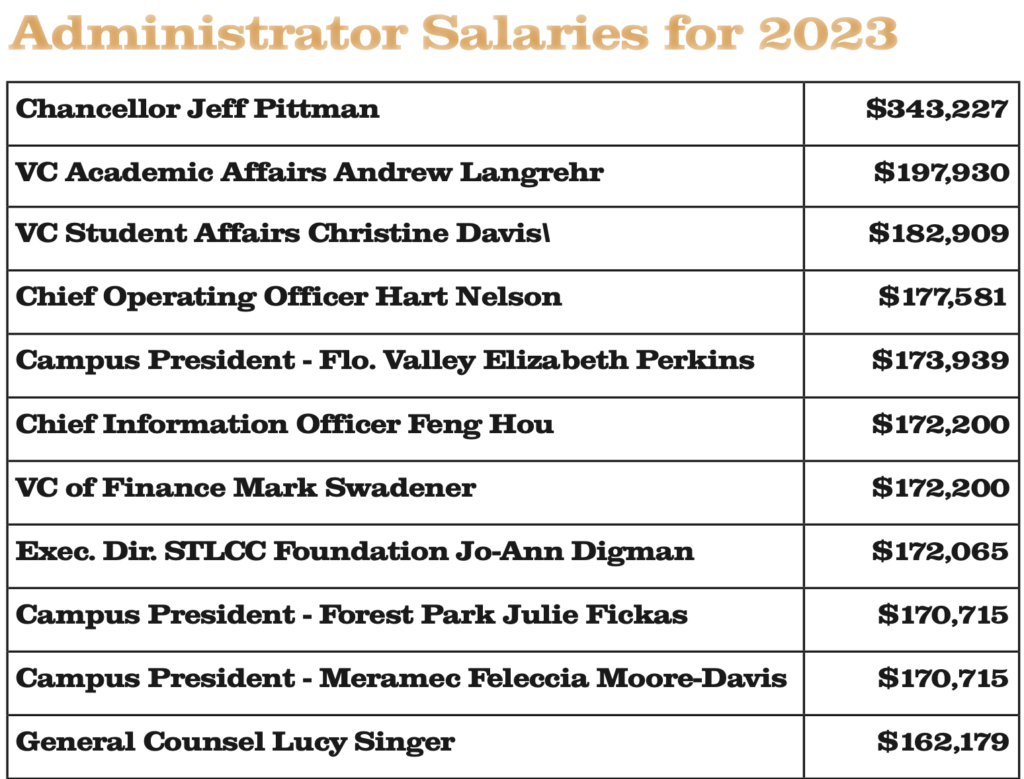
Chancellor Pittman is set to receive a near 13 percent raise this year compared to last year. Pittman’s 2022 salary was listed as being $304,281 and his 2023 salary is set to equal a total of $343,227, marking a $38,946 increase. General Counsel Lucy Singer and IT Security Director Matthew Gioia are set to receive 18.39 percent raises this year, and for the 2023 year are set to earn $169,179 and $117,861, respectively.
The top earners behind Pittman are Vice Chancellor Andrew Langrehr and Vice Chancellor of Student Affairs Christine Davis, who both are set to receive raises of 7.63 percent, thus clearing the way for them to make $197,930 and $182,909, respectively. Right behind them is Chief Operating Officer Hart Nelson, who is set to earn $177,581.
Meramec Campus President Feleccia Moore-Davis is also set for a 7.63 percent raise, and will make a total of $170,715. This is the exact same amount that Forest Park Campus President Julie Fickas is set to make this year, but both are behind Florissant Valley Campus President Elizabeth Perkins, who is set to make $173,939. Perkins is the college’s fifth highest paid employee behind Nelson; Moore-Davis and Fickas are tied for ninth and Singer is the tenth.
Other administrators are also set for raises. Outside of Pittman, Langrehr and Davis, the largest raise percentage increase went to Vice President of Student Success Julie Massey, who received a 10.96 percent raise, bringing her 2023 salary to $120,000.
Overall, the college will spend a total of $5,387,177 paying its salaried administrators. Pittman said that the College continually analyzes salaries based on available market data that allows them to compare the different levels of employee groups in the College with similar positions at other organizations in the St. Louis market. He also said that STLCC recently utilized a third-party vendor to do a market analysis on its professional positions unit and will soon be getting underway with a market study for the unit and non-unit classified positions.
“As demonstrated by the last study, he said, “the College has adjusted compensation for employee groups as needed to align with the area market, and we typically, at least since I have been here, have offered competitive salary increases for all employee units each year, or an increase based on compensation agreed to in negotiations with specific bargaining units.”
He continued, “For the faculty, we have historically had the highest salaries for all community colleges in Missouri, as more than one-third of our full-time faculty make well over $100,000 per year based on recent W-2 data.”
Regarding his own salary, Pittman said he believes he is one of the lower paid administrators when compared to similar size colleges.
“Regarding my salary, again, the board takes market data into consideration. While I do not have exact data, I would estimate I am one of the lower paid administrators of similar size colleges and universities in the St. Louis market, however I truly appreciate that the board continues to make efforts to keep this position competitive in our area,” Pittman said.
Martin clarified the Board’s influence over salaries.
“The Administration presents the Board with recommendations. However, we have many unions that we negotiate with on a good faith basis,” he said. “Each union group determines the salaries of their members through this process. The Board has final approval on such. As a college, we continue to examine and compare our salaries to that of others to remain competitive. This includes not just salaries but also our rich benefit package. The market is currently in a phase that we haven’t seen lately and the Administration is working to present to the Board some possible adjustments in the near future.”
How STLCC got involved with the St. Louis Business Journal
Pittman told The Montage on Monday, “The College works closely with the St. Louis Business Journal on a variety of initiatives and sponsorships to reach the business community, a critical audience for our Workforce Solutions Group as well as all our career programs. Aligning with companies who need well educated workers is a critical part of serving the many key constituents of our service region.”
Pittman himself was a panelist last Friday for the organization’s most recent workforce development panel, and said that STLCC was featured prominently in the Business Journal’s most recent Workforce Development Guide.
“For the College,” he said, “the purpose of participating in the Best Place to Work Survey aligns with our new strategic initiative of becoming a “Best Place to Work” in St. Louis as will be illustrated in the Strategic Plan. While we were not expecting to win the competition this year, we wanted to establish a baseline of information to allow us to assess where our strengths and opportunities are, and to assist us with planning to improve the workplace for the future.”
In an email to faculty and staff sent on Feb. 28, Chair of the STLCC Board of Trustees Kevin Martin said, “We appreciate the efforts to collect feedback from employees through this program and the College’s commitment to making improvements based on that feedback. We are proud to be part of a community dedicated to creating an exceptional student experience and making STLCC a best place to work. Just as within any organization, we are aware that there are opportunities to improve. Further, we recognize the educational landscape is constantly evolving, and change can be challenging. However, we remain committed to adapting to the market to ensure we continue to provide the best possible education for our students. This is one reason our new 2024-2026 Strategic Plan includes the theme of Best Place to Work.”
He later continued, “As we work toward our vision of becoming a top 25 community college, we recognize that change is a necessary part of growth and improvement. We are committed to continually reevaluating and improving our programs and services to ensure that we are meeting the evolving needs of our students and communities. We also recognize the importance of transparency in our decision-making processes, and we are committed to open communication with all stakeholders, including sharing our successes and challenges.”
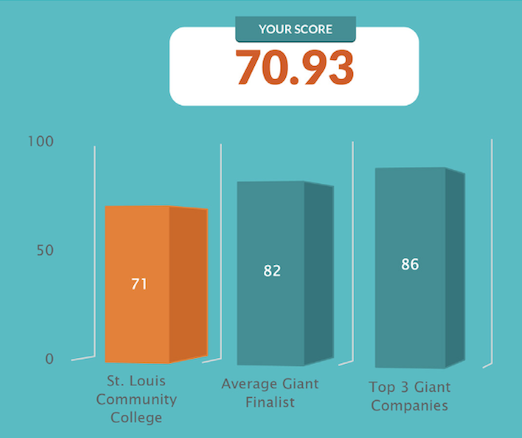
Chancellor Jeff Pittman also sent out an email that day, briefly touching upon the results, and saying “At 70.93, our total score was 11 points lower than the average finalist and 15 points lower than the top three finalists. I believe this is a good baseline and starting point, which will assist us in developing and deploying strategies to assist in improving our workplace.”
Regarding the results, Pittman said on Monday, “While many of us think STLCC is a great place to work given the overall score of the survey – data reflected that 61% of survey respondents reported they were moderately to highly engaged – for the other 39%, we realize that COVID, prior years of very tight budgets, turn-over caused by a tight labor market, and likely other factors have contributed to dissatisfaction and concern to some about the value of employees at STLCC.”
He continued, “We are greatly concerned that only 26% of the respondents feel that senior leaders of the organization value people as their most important resource. Hence, we have developed plans going forward to listen to and address concerns as appropriate to the mission of the College.” Pittman then noted that the “Engage and Listen” plan is available to anyone who would like to review it.
Martin said, “We believe we are a great organization to work at, but also acknowledge we always have room to improve. This is one reason why we began this process. It is a formal way to gather additional feedback on celebrations and opportunities. We need individuals to provide honest, real feedback about the organization. Although this survey is anonymous, we value the information it has provided and allows us to create plans to better engage our stakeholders to meet their needs. We look forward to this becoming an annual thing.”
The faculty’s view on STLCC Transformed
Also of note in more than one of the survey responses was the reaction to STLCC Transformed, with many feeling the project is disorganized. The employee who harshly criticized the chancellor also had harsh words regarding the project.
“The attempt to be defined as one of the best places to work is nothing other than a ploy, just like the STLCC Transformed project,” they said. “As the old saying goes, you can put lipstick on a pig, but it’s still a pig. That’s the essence of St. Louis Community College.”
They elaborate, “The focus on constructing new buildings reiterates the disconnect between leadership and the workforce. Constructing buildings means nothing if you can’t fill them. It certainly means nothing if you don’t have the workforce to support them. As noted by employees who have spent decades with the institution, “this is the worst” some have ever seen it. Many departments are understaffed due to employees leaving over matters that have easy solutions.”
Another survey responder said, “Employees have been given so many versions of what buildings will be built, what will go in them, and what will be torn down, no one knows what is really happening. The board president often speaks of cutting programs, but there is no transparency as to what will stay and what will be cut. While the plans for the new buildings are being constructed, many long-awaited capital projects are being pushed aside. New buildings are exciting, but if the plumbing doesn’t work in the existing buildings, you have a problem. And there is far more than just plumbing issues.”
In contrast, Pittman said he believes the projects are progressing well despite some challenges.
“The projects are progressing on time, and we continue to work diligently to stay within budget despite the high inflation and supply chain issues that are prevalent in the economy.”
He also said that faculty has had opportunities to provide input on the projects.
“We have also offered multiple venues for faculty, staff, and community input on the projects,” he said. “Those faculty and staff who will be housed in the new facilities have been given the opportunity to provide input and assist with architectural planning.”
The renovations at Corporate College
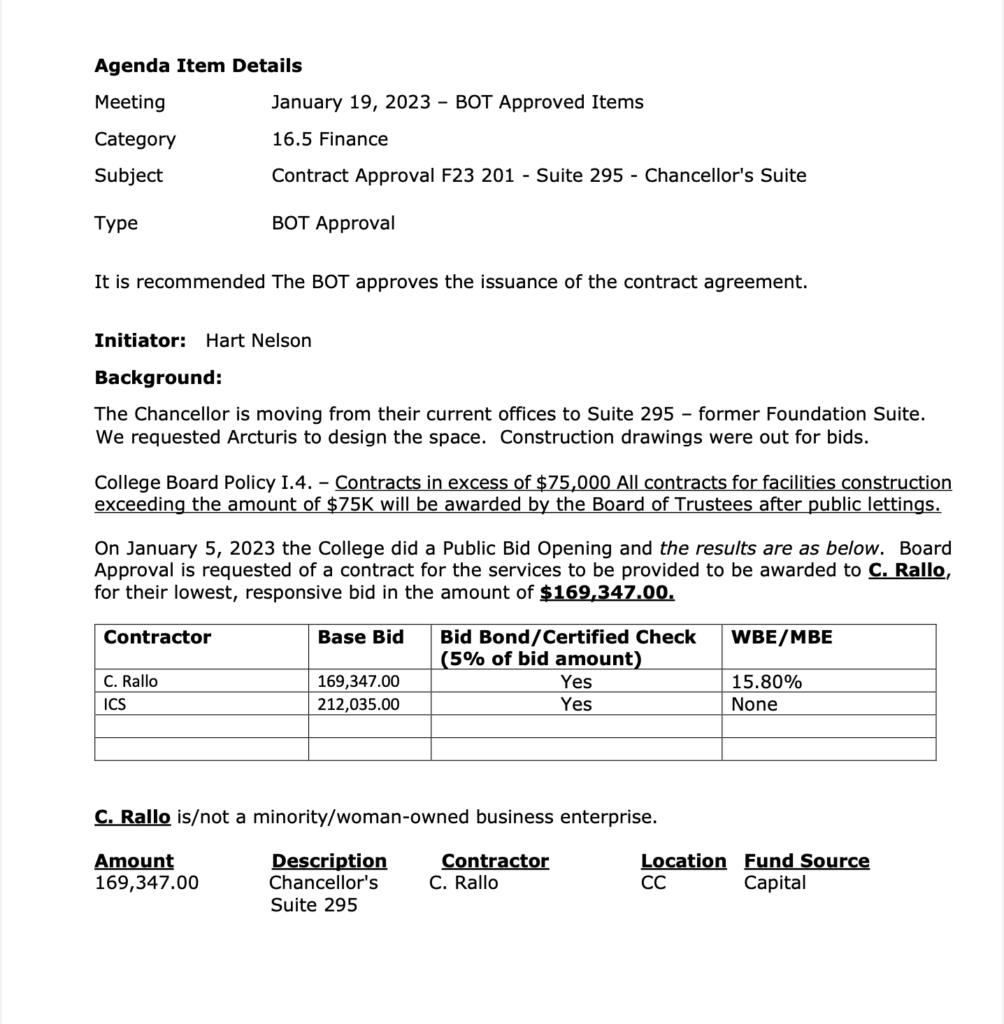
Also of note, and something that appears to have gone unreported elsewhere, is a proposal that can be found in the January Board Of Trustees meeting agenda to move the Chancellor’s Office at the Corporate college building to Room 295, with a potential renovation by contractor C. Rallo set to cost at least $169,347.
Pittman says the purpose behind that project is simple, and revealed where the funding for that project is coming from.
“This project is a result of the College selling our downtown administrative center, the Cosand Center, a few years ago,” he said.
Pittman says that the sale eliminated a cost of approximately $700,000 per year in overhead to the College (and to taxpayers), and proceeds from the sale were reinvested in the new Center of Nursing and Health Sciences for Forest Park’s students and faculty.
He continued, “The building where we currently reside, the Corporate College, was already owned by the College, and lease payments we receive from tenants cover overhead costs. Hence, the sale was a tremendous financial benefit to the College and was yet another strategy to avoid raising student tuition.”
Pittman also revealed that there have been more renovations occurring as a part of this approved proposal. He said that the area covered by this contract will contain multiple offices, a conference room, a copy room and waiting room for visitors to the College.
“Since the sale of Cosand, staff have been placed in offices that were never intended to be permanent,” he said. “We have been reconfiguring space at Corporate College to make it more effective for the needs of employees who have been displaced from the Cosand sale.”
He also says that those other parts of the project have taken priority.
“The primary reason I have waited to do my space last is to make sure all the other staff had their offices in place first,” said Pittman.
The Board of Trustees meets for its next public session on April 20th in Room 219 of the Corporate College building.








